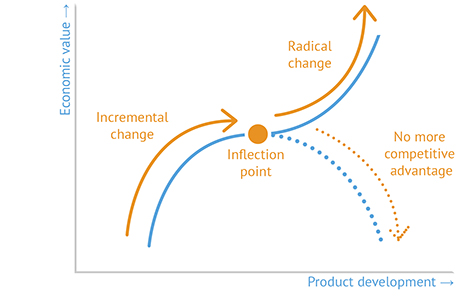Vision

Challenge
To be competitive, businesses renew their products, mostly by making incremental changes. But at some point, these changes don’t make a product competitive anymore. It requires a change in strategy. “The progression of economic value” describes that businesses go through economic progression by shifting from commodities to services to experiences. 31Volts, a service design studio, relates this model to the inflection point1, a mathematical phenomenon. It is a metaphor for increasing economic value. When incremental changes do not give any competitive advantage anymore, radical change is required. The current trend for technology companies is to shift from a product-focused strategy to a service-focused strategy. This shift to services is the first step into gaining competitive advantage. As FastCompany states, investing into user experience creates true customer satisfaction and loyalty2. It’s about designing for the total user experience even before and after the touch points within the service.
Approaches
Currently, many companies shift to a service mindset. For example, Océ Technologies sells ink cartridges and paper along with their printers. This is a service that corporate clients pay for to use Océ printers. Other technology companies make this shift as well; Microsoft transitions from product-centered (selling copies of Windows or other software packages) to service-centered (launching free online services like Office365 with a premium plan, or offering free upgrades to Windows 10). This, however, is still not considering user experience. It does not create loyalty, and customers can easily switch to competitive services like Google Drive.
How it should be done
The movie industry teases with previews of upcoming movies to spark interest. A Southwest pilot ordered pizza for the passengers of a delayed airplane to displace the negative experience with a positive surprise. Any business could profit from these kind of actions to improve customer experience. As an interaction designer or user experience designer, I design the total user experience. I take into account how I can design the experience of the interactions with customers and the moments in between. For example, as FastCompany states, by teasing and tempting for creating anticipation, using the element surprise to get positive like-never-before experiences, making something special or displacing the negative experience to make the positive experiences more memorable and focusing on the end of the service journey to deliver a final positive memory2.
1 = Designing value beyond the inflection point, Marc Fonteijn (2010)
http://www.31volts.com/en/2010/02/designing-value-beyond-the-inflection-point/
2 = 6 Tips for designing happiness, Randall Stone, Dan Clay (2015)
http://www.fastcodesign.com/3047190/6-tips-for-designing-happiness
Identity

I am interested in software interaction design, which I like to approach from a service design perspective. While designing a service, I like to take into account the omni-channel setup, which spans over various service touch points (smartphone apps, websites, storefronts, etc.). For this, I obtain a holistic overview on the user experience through engaging discussion by means co-reflection and co-constructing stories. I prefer to confront stakeholders (users, experts, clients, multidisciplinary team members) with the concept by using tangible deliverables from the design process to evoke discussion. As FastCompany states, a service designer should focus not only on the interactions with the customer, but also on what comes before and after1. Aforementioned methods, along with value laddering, are tools for finding out about this experience, and how to improve it.
Regarding service design and designing for the user experience, I see potential both within R&D of technology companies and within developing my own idea further: the app CoCap. Both can coexist, as I can divide my time to work in R&D and pursuing my personal dream of developing the app CoCap.
Comparing my M1.1 with my M1.2, I found that I like designing towards a product or service, rather than performing research as input for design. I realize this defined me as the designer who I want to be: a service designer with emphasis on user experience in the context of software interaction design.
1 = 6 Tips for designing happiness, Randall Stone, Dan Clay (2015)
http://www.fastcodesign.com/3047190/6-tips-for-designing-happiness